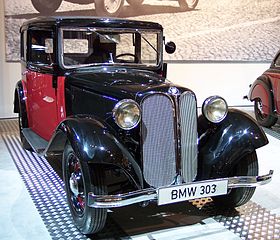BMW 329
| BMW 303 | |
|---|---|

1933 BMW 303
|
|
| Overview | |
| Manufacturer | BMW |
| Production |
303: 1933–1934 315: 1934–1937 319: 1935–1936 329: 1937 |
| Assembly | Eisenach, Thuringia, Germany |
| Body and chassis | |
| Class | Small family car |
| Body style |
303, 315, 319: 2-door saloon, 2-door cabriolet 329: 2-door or 4-door cabriolet |
| Layout | FMR layout |
| Platform | BMW 303 |
| Related | BMW 309, BMW 315/1, BMW 319/1, BMW 328 |
| Powertrain | |
| Engine |
BMW M78 OHV I6 303: 1,173 cc (71.6 cu in), 30 PS (22 kW; 30 hp) at 4000 rpm 315: 1,490 cc (90.9 cu in), 34 PS (25 kW; 34 hp) at 4000 rpm 319, 329: 1,911 cc (116.6 cu in), 45 bhp (33.6 kW) at 3750 rpm |
| Transmission | 4-speed manual, synchromesh on 3rd and 4th |
| Dimensions | |
| Wheelbase | 2,400 mm (94.5 in) |
| Length | 3,900 mm (153.5 in) |
| Width | 1,440 mm (56.7 in) |
| Height | 1,550 mm (61.0 in) |
| Kerb weight | 1,808 lb (820 kg) |
| Chronology | |
| Successor |
BMW 315 (model) BMW 320 (series) |
| BMW 309 | |
|---|---|

1934 BMW 309
|
|
| Overview | |
| Manufacturer | BMW |
| Production | 1934–1936 |
| Assembly | Eisenach, Thuringia, Germany |
| Body and chassis | |
| Class | Small family car |
| Body style | 2-door saloon, 2-door cabriolet, 2-door tourer |
| Layout | FMR layout |
| Platform | BMW 303 |
| Related | BMW 303, BMW 315, BMW 319 |
| Powertrain | |
| Engine | OHV I4 |
| Dimensions | |
| Wheelbase | 2,400 mm (94.5 in) |
| Length | 153.5 in (3,899 mm) |
| Kerb weight | 1,654 lb (750 kg) |
| Chronology | |
| Predecessor | BMW 3/20 |
| Successor | BMW 600 |
| BMW 315/1, BMW 319/1 | |
|---|---|

BMW 315/1 roadster
|
|
| Overview | |
| Manufacturer | BMW |
| Production |
315/1: 1934–1937 319/1: 1935–1937 |
| Assembly | Eisenach, Germany |
| Designer | Peter Schimanowski |
| Body and chassis | |
| Class | Sports car |
| Body style | roadster |
| Layout | FR layout |
| Related | BMW 319/1 BMW 328 |
| Powertrain | |
| Engine |
BMW M78 OHV I6 315/1: 1,490 cc (90.9 cu in), 40.6 PS (29.9 kW; 40.0 hp) at 4300 rpm 319/1: 55 bhp (41.0 kW) at 4000 rpm |
| Transmission | 4-speed manual |
| Dimensions | |
| Wheelbase | 2,400 mm (94.5 in) |
| Length | 3,800 mm (149.6 in) |
| Width | 1,440 mm (56.7 in) |
| Height | 1,350 mm (53.1 in) |
| Kerb weight | 750 kg (1,653 lb) |
| Chronology | |
| Predecessor | BMW Wartburg |
| Successor | BMW 328 |
The BMW 303 was a small family saloon produced by BMW in 1933 and 1934. It was the first BMW motor car with a six-cylinder engine and the first BMW motor car with the "kidney grille" associated with the brand. The platform developed for the 303 was used for several other BMW cars, including the BMW 309, a four-cylinder version of the 303, the BMW 315, a 1.5-litre version of the 303 which replaced it in 1934 and was built until 1937, the BMW 319, a 1.9-litre version of the 303 produced alongside the 315 from 1935 to 1937, and the BMW 329, a development of the 319 with styling based on the newer, larger BMW 326, that briefly replaced the 319 in 1937.
The 303 platform was also used for the BMW 315/1 and BMW 319/1. These were high-performance versions of the 315 and 319 respectively, with tuned engines and lightweight roadster bodywork. The 315/1 and 319/1 were replaced by the BMW 328 in 1936.
Upon its introduction in 1933, the 303 was the largest car BMW had made. The wheelbase of the 303 was 2,400 millimetres (94.5 in), an increase of 300 millimetres (11.8 in) over the 3/20. The track, 1,150 millimetres (45.3 in) at the front and 1,220 millimetres (48.0 in) at the rear, was also wider than the 3/20's 1,100 millimetres (43.3 in) front and rear. Unlike the 3/20's backbone chassis, the 303 had a ladder frame made from tubular side members and box-section cross members.
The independent front suspension used a transverse mounted leaf spring mounted above the wheel centre line. The hubs were located with the spring mounts at the top and control arms at the bottom. The rear suspension used a live axle on semi-elliptic leaf springs, a conventional system neither as advanced nor as troublesome as the 3/20's swing axles.
...
Wikipedia
